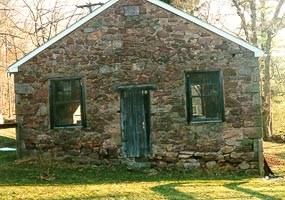|
For the 112 year history of Hopewell Furnace (1771-1883), African-Americans played an important role in one of the area's most active industries. The builder of the furnace, Mark Bird, along with most ironmasters in the 18th century, was a slave owner. In 1780 Bird was listed as the largest slave owner in Berks County. He had 10 men, 4 women, 3 boys and 1 girl. These slaves worked at his forges in Birdsboro and are said to have dug Hopewell's original headrace that turned the water wheel supplying air to fire the furnace. Over two centuries after the erection of the furnace, visitors can see remnants of the east headrace near the Big House. Although slavery in Berks County declined rapidly after 1780 when the state assembly passed an act ordering gradual emancipation, African-American's continued to work at Hopewell. "Black Bill" Jacobs lived his entire life of about 100 years at Hopewell, working first as a teamster, then as a coachman and a gardner. Some of Hopewell's African-American workers lived in the nearby woodlands. Beginning in 1835 this remote area around Hopewell figured prominently in the Underground Railroad movement. Runaway slaves from the south came across the Pennsylvania border and over the intervening hills to the home of Elizabeth Scarlet and her son Joseph, the Quaker owners of Scarlet's Mill. Here a community founded by African-Americans from the south who had escaped their bondage grew up in the valley of Six Penny Creek, close to Hopewell, Joanna Furnace and the forges in Birdsboro. Many former slaves earned their living supporting the iron industry working as woodcutters, colliers, and teamsters. Some, such as Isaac Cole, became landowners too. The names of runaway slaves employed as woodcutters were probably not entered into the furnace records in order to protect their identities. Some may have worked for contractors, thereby not showing up in Hopewell's records. African-American workers such as Draper Nixon, Edward Ford, Stephen Brown, Peter and Henry Jones, John Hart, and Joseph Tolbert were credited in 19th century Hopewell journals for cutting cord wood used to produce charcoal to fuel the furnace, Other African-Americans worked as teamsters, hostlers, colliers, miners, fillers and maids.

NPS photo. |
Last updated: February 4, 2025
